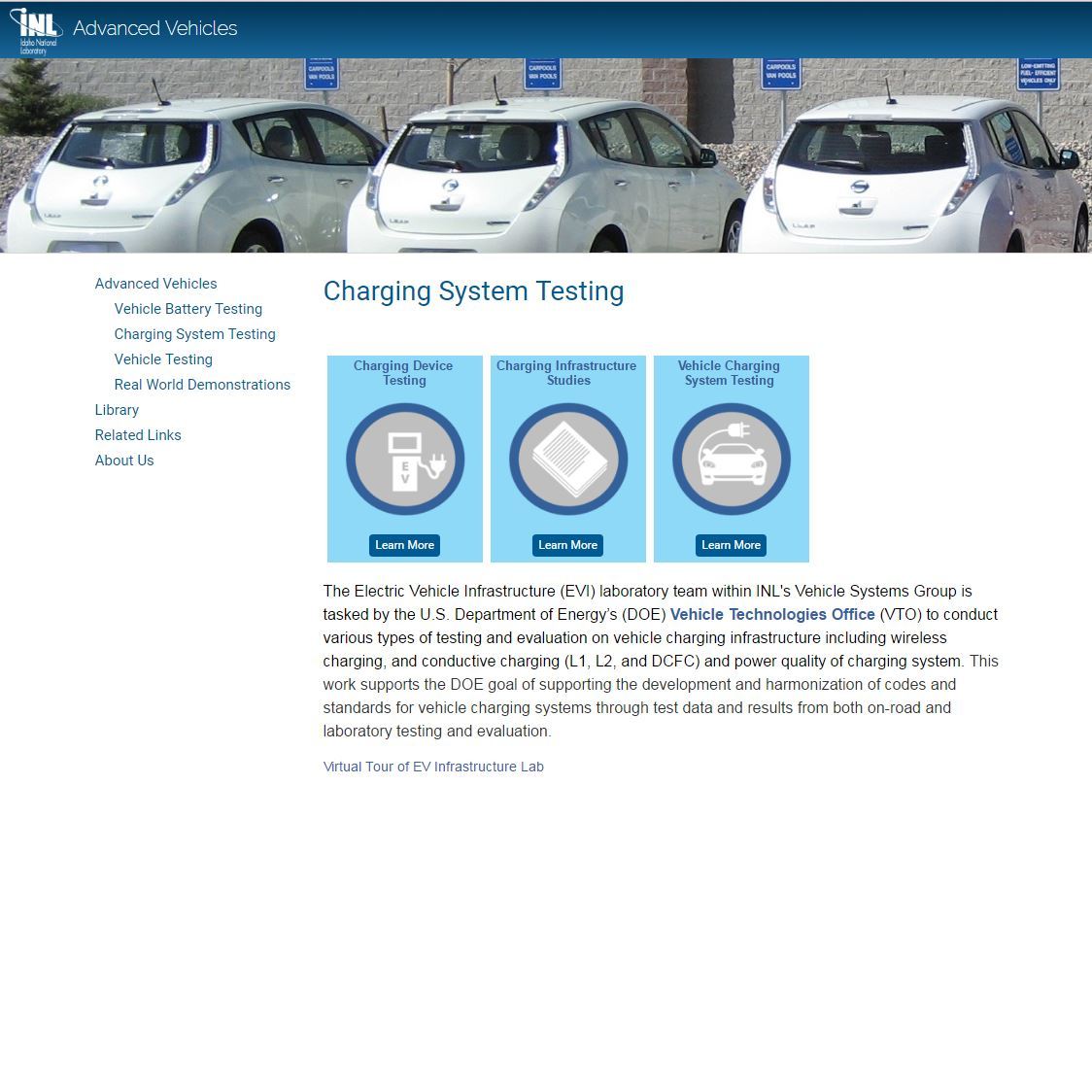Grid Integration of EV Charging Infrastructure
INL's EV infrastructure lab is integrated with INL's Digital Real-Time Simulators and four quadrant grid emulator capable of 540 kVA, thus allowing for in-depth HIL simulation testing to characterize the interaction between emerging EV charging technology and the dynamics of grid distribution and transmission systems. Systems are characterized across a wide range of use cases and conditions to understand the following:
Electrical interactions between charging systems and the electric grid
Functional interoperability between charging equipment and vehicles
Controls requirements for integration of EVs with the electric grid and the potential for EV charging infrastructure to provide grid services
Solutions are developed to ensure grid distribution feeder stability and robustness with the growing EV market and increasing charging power to reduce charge time.
EVIL also has capabilities integrated with INL's integrated energy systems (IES) which integrate multiple energy inputs (e.g., nuclear, fossil, renewable energy) and multiple energy outputs (e.g., electricity, transportation fuels, industrial chemicals, fresh water). INL's work in IES has included the development of advanced computational environments consisting of models, physical assets, and HIL components to design, analyze, and optimize IES configurations for best meeting requirements under given constraints. This work has also been used to synthesize predictive monitoring and control strategies that enable IES for automatic adaptation to varying markets and O&M conditions. INL applies model-based design and operation strategies to accommodate high system variability conditions arising from the integration of renewable energy and modern loads (e.g., electric vehicles) into the power grid.
EV Wireless Power Transfer (WPT) EM-field Safety
Wireless power transfer (WPT) is a viable solution for fully autonomous vehicle charging either while parked (stationary) or while in motion (dynamic). WPT offers high efficiency charging and consumer convenience, but stray field emissions near the WPT system may be a safety concern at high power levels. To mitigate the safety concerns of high EM-field around the WPT system, INL's EV infrastructure lab develops advanced EM-field shielding and shaping solutions to control the field and maximize the EM-field density within the WPT system while minimizing the stray EM-field around the outside of the WPT system. This is an especially important challenge to solve, as WPT power level increases to reduce recharge times.

Cyber-Physical Security of EV Charging Infrastructure
INL's EV infrastructure lab collaboratively conducts cybersecurity vulnerability assessments and penetration testing with multiple organizations. This testing is conducted on advanced EV charging infrastructure to determine physical, communication, and controls system vulnerabilities that may lead to compromised security or safety in the vehicle, charging infrastructure, and/or grid systems. INL has a robust suite of hardware and software tools to evaluate device firmware, communication systems, and physical security to prevent unauthorized access. INL additionally utilizes consequence-based analysis methodology to prioritize cybersecurity threats and vulnerabilities for an EV charging system. This methodology adds in prioritizing research within the large landscape of potential vulnerabilities, threats, and attack pathways.
Operational Performance Characterization of EV Charging Infrastructure
INL's EVIL maintains rigorously vetted safety procedures, charging evaluation test procedures, and logistics processes to conduct the operational performance characterization of high-power EV charging infrastructure. The lab has facility grid power capacity of more than 800kVA up to 480 VAC 3-ph. to operate the charging infrastructure. EVIL utilizes numerous charging systems up to 350kW with a wide range of charging protocols to enable the evaluation of light-duty, medium-duty, and heavy-duty charging characteristics.

The experience and lab capabilities at EVIL have enabled extensive testing programs to support standards organizations in the development of EV charging technologies recommended practices. This extensive verification testing accelerates the standardization process by providing quantitative results by testing the proposed standardized designs, requirements, methodologies, and guidelines.
INL also performs field studies of EV charging infrastructure and houses several years of real-world EV fleet data that contains information on consumer use patterns for both EVs and charging infrastructure. These data allow researchers to develop realistic aggregate local and regional grid demand profiles that are required for accurate grid simulation.
INL's EVIL lab is unique in that it offers an integrated suite of resources including vehicle charging system device characterization, modeling expertise, real-world customer use data archives, grid simulation, and cybersecurity expertise within a single facility. These specialized capabilities and expertise allow for a comprehensive approach to EV charging infrastructure solution development, verification, and validation. There are numerous benefits of working with INL's EV infrastructure lab, where staff perform electric vehicle to grid integration research and testing through targeted laboratory experimentation, collection of real-world field data, and data-driven modeling to characterize advanced EV charging systems.
RELATED WEBSITE

Advanced Vehicles Research/Publications

